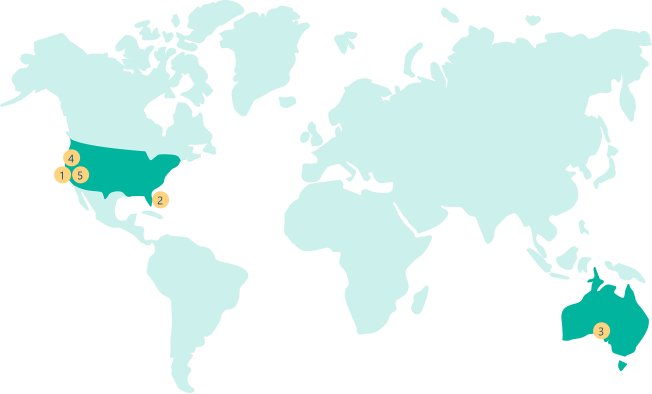

Transmission and Storage
The U.S. Grid
The US power grid is actually not one grid, but is made up of three main sections: the Eastern Interconnection, the Western Interconnection, and the Lone Star State’s ERCOT grid. The Texas grid is a bit different from the other national grids because it is not connected to these other grid networks, meaning it cannot easily transmit energy into or out of the state. As we transition to more renewable sources, energy storage will become an increasingly important factor in the future because it will allow the grid to store the energy produced during peak hours to use it when renewable sources are unavailable.
Here’s how we transport electricity
from the source to you
(Shown as Natural Gas).

WESTERN
EASTERN
ERCOT
ERCOT
1
Gas Production
Natural Gas is extracted from the ground
2
Gas Processing
Natural Gas is processed and sent to the City Gate
3
City Gate
Natural Gas is received, processed and sent to the power plant
4
Power Plant
Natural Gas is transformed into electricity and sent to the city
5
Home and Business
1
Gas Production
Natural Gas is extracted from the ground
2
Gas Processing
Natural Gas is processed and sent to the City Gate
3
City Gate
Natural Gas is received, processed and sent to the power plant
4
Power Plant
Natural Gas is transformed into electricity and sent to the city
5
Home and Business
The ERCOT grid is isolated from the rest of the U.S., which makes it hard to inject energy from other sources outside the grid. Having stored, potential, energy would be ideal but, are we there yet?
Battery
- Electrical energy stored in DC
- Discharge the electrical energy to grid via PCS
BMS (Battery Managment System)
- Monitoring battery’s current, voltage, temperature, SOC, devices status
- Exchange information and data to communicate with PCS
FFS (Fire Fighting System)
PMS (Power Managment System)
- Monitor and estimate power consumption and active operation
- A real-time information recived from PCS to monitor the ESS
- The ESS managment according to the host controller command
- Managment system history and version
- Faulty condition, remote maintenance for recovery available
PCS (Power Conditioning System)
- Invert DC power stored in batteries to AC power with voltage and frequency of commercial
- Convert AC power to DC charged in batteries
Explore





The Truth on Energy Storage
Although we have been advancing our battery and storage technology, we are not yet at the point where we could count on powering a city with battery power for a long time. See some stats below.
THE LATEST FORM OF SOLAR READY STORAGE
Grid-Scale Battery Storage

40’ container 1MWh - Cost Range: $300,000 - $800,000
Battery
- Electrical energy stored in DC
- Discharge the electrical energy to grid via PCS
BMS (Battery Managment System)
- Monitoring battery’s current, voltage, temperature, SOC, devices status
- Exchange information and data to communicate with PCS
FFS (Fire Fighting System)
PMS (Power Managment System)
- Monitor and estimate power consumption and active operation
- A real-time information recived from PCS to monitor the ESS
- The ESS managment according to the host controller command
- Managment system history and version
- Faulty condition, remote maintenance for recovery available
PCS (Power Conditioning System)
- Invert DC power stored in batteries to AC power with voltage and frequency of commercial
- Convert AC power to DC charged in batteries
With one of these 1 MWh container batteries, you’d have electricity for:
1.2
Months of power for an average U.S. home
2
Refrigerators run for a year
3.6x
Trips across Texas North to South
260
Watt light bulbs run nonstop for a year
With 1,000 of these you’d have 1 GWh of power, which is enough electricity to:
1 GW would power the
Dallas DART light rail system for about
3 days
Vistra Moss Landing Energy Storage Facility
Location: California, US
Developer: Vistra Energy Corporation
Capacity: 400MW/1,600MWh
Manatee Energy Storage Center Project
Location: Florida, US
Developer: Florida Power & Light (FPL)
Capacity: 409MW/900MWh
Victorian Big Battery
Location: Near Geelong, Australia
Developer: Neoen
Capacity: 300MW/450MWh
McCoy Solar Energy Project BESS
Location: California, US
Developer: NextEra Resources
Capacity: 230MW/920MWh
Elkhart Battery
Location: California, US
Developer: Pacific Gas and Electric Company (PG&E)
Capacity: 182.5MW/730MWh

The biggest 5 batteries in the world, combined, store
of sable capacity
This would be enough to power Houston homes for less than 3 hours.

Vistra Moss Landing Energy Storage Facility
Location: California, US
Developer: Vistra Energy Corporation
Capacity: 400MW/1,600MWh
Manatee Energy Storage Center Project
Location: Florida, US
Developer: Florida Power & Light (FPL)
Capacity: 409MW/900MWh
Victorian Big Battery
Location: Near Geelong, Australia
Developer: Neoen
Capacity: 300MW/450MWh
McCoy Solar Energy Project BESS
Location: California, US
Developer: NextEra Resources
Capacity: 230MW/920MWh
Elkhart Battery
Location: California, US
Developer: Pacific Gas and Electric Company (PG&E)
Capacity: 182.5MW/730MWh
The biggest 5 batteries in the world, combined, store
4.6 GWhof sable capacity
This would be enough to power Houston homes for less than 3 hours.
The Moss Landing Energy Storage Facility has a capacity of 400 MW / 1600 MWh and has a footprint of 3 football fields.
It would power Dallas for about
19 hoursFrom a cost perspective, powering our homes with batteries is still unattainable for most Americans
With current technology it cost us triple the amount to store electricity in comparison to just using it at the point of being generated by solar panels
To power an average Texas home you would need at least 3 Tesla Powerwall Units + Solar + the actual sunshine
Sunlight
3 powerwall system
$25,500
Will need to replace after 20 years
Solar Hardware
$20,000
Total
$45,500
ANOTHER FORM OF ENERGY STORAGE IS
Pumped-Storage Hydropower
According to the 2021 edition of the Hydropower Market Report, PSH currently accounts for 93% of all utility-scale energy storage in the United States.
America currently has 43 PSH plants and has the potential to add enough new PSH plants to more than double its current PSH capacity.
Excess energy from the grid is used at times of low demand to pump water uphill
When demand rises, or there is a shortage of supply from other sources, water is released downhill
Water runs through a turbine to generate electricity
Electricity is sent to the grid via a tranformer
Water-Flow Direction
Producing
Pumping
Water-Rotation Direction
Producing
Pumping
Pros and Cons of Pumped-Storage Hydropower
Pros
Low operating cost and long service life
Renewable and sustainable
Minimal environmental repercussions
Controllability
Can Promote Recreational activities
Water supply and flood control
Cons
High startup cost relative to other technologies
Energy loses
Possibility of affecting aquatic life and habitats due to sedimentation
Impact on water quality
Climate dependent
Constrained by the necessary geographic features